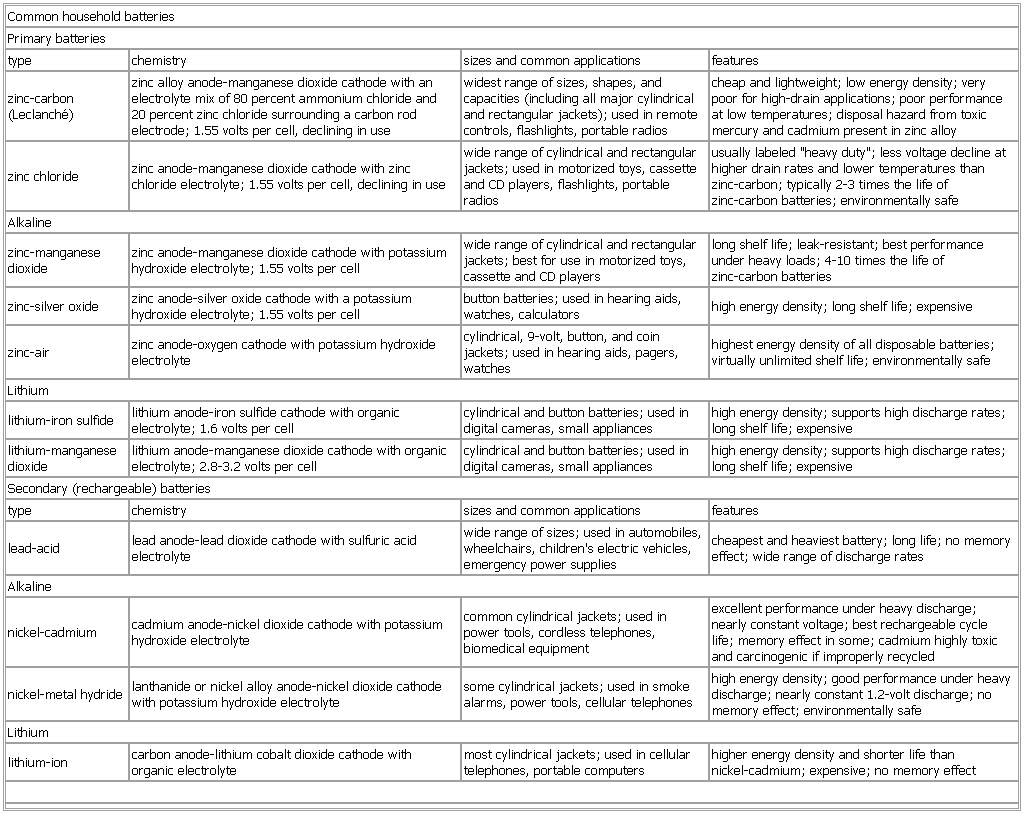- Common household batteries
-
▪ TableCommon household batteriesPrimary batteriestype chemistry sizes and common applications featureszinc-carbon (Leclanché) zinc alloy anode-manganese dioxide cathode with an electrolyte mix of 80 percent ammonium chloride and 20 percent zinc chloride surrounding a carbon rod electrode; 1.55 volts per cell, declining in use widest range of sizes, shapes, and capacities (including all major cylindrical and rectangular jackets); used in remote controls, flashlights, portable radios cheap and lightweight; low energy density; very poor for high-drain applications; poor performance at low temperatures; disposal hazard from toxic mercury and cadmium present in zinc alloyzinc chloride zinc anode-manganese dioxide cathode with zinc chloride electrolyte; 1.55 volts per cell, declining in use wide range of cylindrical and rectangular jackets; used in motorized toys, cassette and CD players, flashlights, portable radios usually labeled "heavy duty"; less voltage decline at higher drain rates and lower temperatures than zinc-carbon; typically 2-3 times the life of zinc-carbon batteries; environmentally safeAlkalinezinc-manganese dioxide zinc anode-manganese dioxide cathode with potassium hydroxide electrolyte; 1.55 volts per cell wide range of cylindrical and rectangular jackets; best for use in motorized toys, cassette and CD players long shelf life; leak-resistant; best performance under heavy loads; 4-10 times the life of zinc-carbon batterieszinc-silver oxide zinc anode-silver oxide cathode with a potassium hydroxide electrolyte; 1.55 volts per cell button batteries; used in hearing aids, watches, calculators high energy density; long shelf life; expensivezinc-air zinc anode-oxygen cathode with potassium hydroxide electrolyte cylindrical, 9-volt, button, and coin jackets; used in hearing aids, pagers, watches highest energy density of all disposable batteries; virtually unlimited shelf life; environmentally safeLithiumlithium-iron sulfide lithium anode-iron sulfide cathode with organic electrolyte; 1.6 volts per cell cylindrical and button batteries; used in digital cameras, small appliances high energy density; supports high discharge rates; long shelf life; expensivelithium-manganese dioxide lithium anode-manganese dioxide cathode with organic electrolyte; 2.8-3.2 volts per cell cylindrical and button batteries; used in digital cameras, small appliances high energy density; supports high discharge rates; long shelf life; expensiveSecondary (rechargeable) batteriestype chemistry sizes and common applications featureslead-acid lead anode-lead dioxide cathode with sulfuric acid electrolyte wide range of sizes; used in automobiles, wheelchairs, children's electric vehicles, emergency power supplies cheapest and heaviest battery; long life; no memory effect; wide range of discharge ratesAlkalinenickel-cadmium cadmium anode-nickel dioxide cathode with potassium hydroxide electrolyte common cylindrical jackets; used in power tools, cordless telephones, biomedical equipment excellent performance under heavy discharge; nearly constant voltage; best rechargeable cycle life; memory effect in some; cadmium highly toxic and carcinogenic if improperly recyclednickel-metal hydride lanthanide or nickel alloy anode-nickel dioxide cathode with potassium hydroxide electrolyte some cylindrical jackets; used in smoke alarms, power tools, cellular telephones high energy density; good performance under heavy discharge; nearly constant 1.2-volt discharge; no memory effect; environmentally safeLithiumlithium-ion carbon anode-lithium cobalt dioxide cathode with organic electrolyte most cylindrical jackets; used in cellular telephones, portable computers higher energy density and shorter life than nickel-cadmium; expensive; no memory effectSee as table:

* * *
Universalium. 2010.
